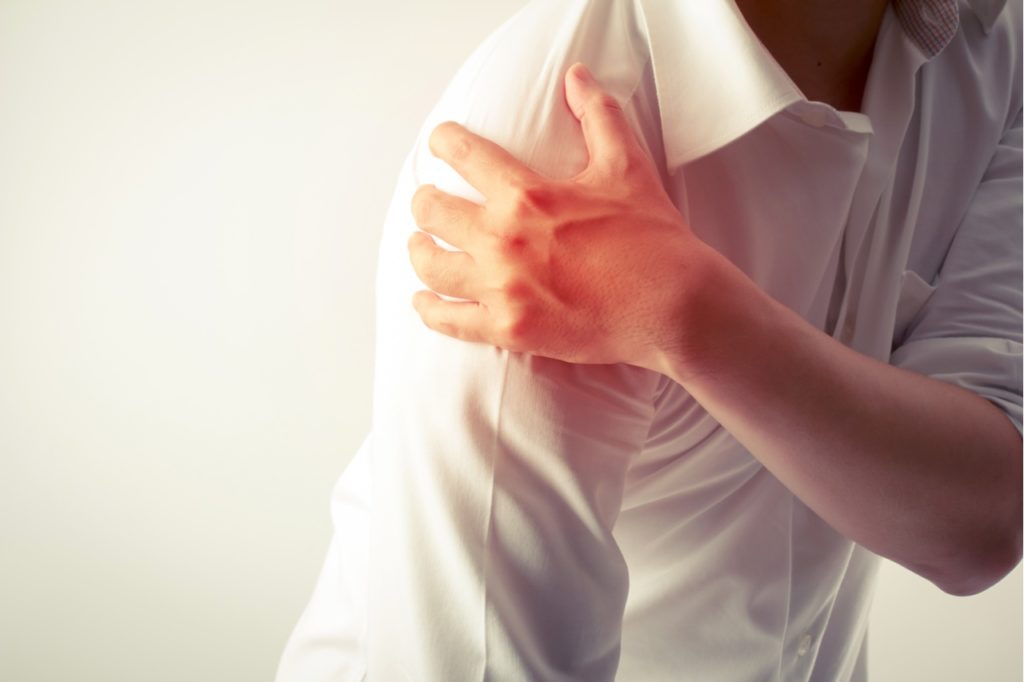The shoulder is the most complex joint in the body. Made up of many different bones, tendons, and ligaments, its complex structure is what makes it so integral to sports and everyday life. Unfortunately, it also makes the shoulder particularly vulnerable to a variety of injuries.
The shoulder’s complexity can also make it difficult to diagnose specific conditions affecting it, since so many share the same general symptom: pain when lifting the arm. To help you identify your issue, we’ve broken down some of the most common causes of shoulder pain and the particular actions that can exacerbate them.
SLAP TEAR
SLAP tears (superior labral tear from anterior to posterior) are caused by a tear or lesion in the labrum, the soft rim of cartilage lining the socket of the shoulder joint. They can be caused by any sort of physical activity, from weightlifting to picking up a book from a shelf, and typically result in deep pain and decreased strength in the shoulder, a limited range of motion in all directions, and an inability to raise the arms overhead. Generally diagnosed through a series of physical tests and exams, SLAP tears can be temporarily debilitating, but with proper treatment, they usually don’t result in a long-term loss of function.
SHOULDER IMPINGEMENT
Sometimes referred to as shoulder bursitis, tennis shoulder, or swimmer’s shoulder, shoulder impingement syndrome occurs when the tendons or bursa (the thin, fluid-filled cushions surrounding the shoulder joint) are caught between the tip of the acromion and the humerus, almost always as a result of bone spurs. Common symptoms include heavy pain in the arm or shoulder when lifting, moving, or lying on the arm, difficulty sleeping, and decreased strength in the shoulder.
SHOULDER ROTATOR CUFF TEAR
A rotator cuff tear is a rupture of one of the tendons in the shoulder responsible for raising the arm. Most patients experience a limited range of motion, and pain and weakness that increases when lifting the arm overhead. Rotator cuff tears may be diagnosed using a simple, at-home test: start by raising your arm, noting whether it hurts when it reaches over your head, and then hold the arm out to shoulder level before slowly bringing it down. If it suddenly drops to your side, you may have a torn rotator cuff. Seek a formal diagnosis from an orthopedic specialist if you suspect that you have suffered this injury.
SHOULDER DISLOCATION
Shoulder dislocations occur when the ball of the shoulder joint is forced out of the socket, generally after sustaining sudden trauma. The telltale symptoms of a dislocation are intense pain immediately following the injury, a complete inability to move the arm, and a misshapen shoulder. A dislocated shoulder should be reset in the emergency room as soon as possible, but patients will need to follow up with an orthopedic specialist who can determine the extent of the injury and develop an appropriate course of treatment.
WEIGHTLIFTER’S SHOULDER
Weightlifter’s shoulder, also called AC joint osteolysis, is characterized by a series of small fractures along the end of the collarbone which gradually erode the bones within the AC joint (the junction connecting the collarbone and the shoulder blade). Common symptoms include a dull pain or ache in the AC joint, pain and tenderness when applying pressure to the top of the shoulder, swelling at the end of the collarbone or in the AC joint, and decreased strength in the shoulder.
LOOSE BODIES IN THE SHOULDER
Loose bodies in the shoulder occur when pieces of dislodged bone or cartilage become trapped in the synovium, the thin membrane surrounding the shoulder joint. This can be caused by either gradual degeneration of the cartilage or sudden trauma to the area. While most patients with loose bodies experience no symptoms whatsoever, these fragments can cause moderate to severe pain and a catching or locking sensation if they become caught in the joint.
Whether your shoulder pain is caused by a sports injury or something else, you should always consult a professional before beginning treatment. With decades of combined experience treating shoulder injuries, New York Bone and Joint can quickly diagnose, treat, and rehabilitate a variety of shoulder problems, from minor tears to complete dislocations. Call today to schedule an appointment.




